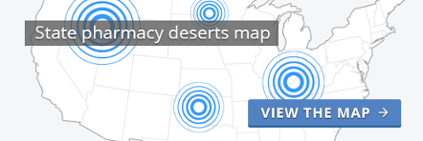Do you know patients located in pharmacy deserts? What is a pharmacy desert, anyway? If all that comes to mind is a tumbleweed and an empty orange prescription vial drifting across a rough, dusty terrain, you should keep reading.

Nearly 70 percent of Americans are on at least one prescription drug, yet pharmacy deserts continue to affect millions of patients each and every day. Let’s dive in and learn the definition of a pharmacy desert and where they are located.
The definition of a pharmacy desert
A one definition fits all doesn’t quite work when defining pharmacy deserts. Let’s take a look at two definitions that will help paint the picture — beyond the tumbleweeds — for you.
Urban definition:
An urban pharmacy desert is defined as a low-income community or neighborhood with no pharmacy within a half-mile for those with limited vehicle access. For low-income communities with adequate vehicle access, the defining radius extends to a mile.
This definition was originally devised by Dr. Dima Qato, Assistant Professor in the Department of Pharmacy Systems, Outcomes, and Policy at the University of Illinois Chicago (UIC) for a study regarding pharmacy access points in an urban setting. The UIC developed this definition based off what the USDA came up with for the definition of a food desert — or a low-income census tract where a substantial number of residents have low access to a supermarket or large grocery store. The USDA defines “low access” as more than one mile from a supermarket or large grocery store in an urban setting and more than 10 miles away from either store in a rural setting.
While these parameters may not seem substantial, patients living in dense urban areas with pharmacy access issues would tell you otherwise.
Rural definition:
A rural pharmacy desert is defined as any area within a 10-mile radius without ready access to a pharmacy (for those that have access to transportation).
As an extension of the UIC’s language for an urban pharmacy desert, TelePharm developed the definition of a rural pharmacy desert above. As with the UIC, this definition is based off the methodology used by the USDA.
Rural pharmacy deserts
When thinking about limited access to pharmacy care, rural communities come to mind.
According to a study by the RUPRI Center for Rural Health Policy Analysis, the number of independently owned rural pharmacies open in the United States saw a significant decline over a 10-year span in the 2000s. Located at the University of Iowa College of Public Health, the RUPRI also found that:
- From March 2003 to December 2013, there was a loss of 924 (12.1%) independently owned rural pharmacies in the United States. The most drastic loss occurred between 2007 and 2009. From 2010-2013, the trend has been for more closures, although the decline is not as pronounced or clear as in earlier years.
- Four hundred ninety (490) rural communities that had one or more retail pharmacy (including independent, chain, or franchise pharmacy) in March 2003 had no retail pharmacy in December 2013.
Without local access to pharmacy care, patients can become less adherent to their medications, which may affect their overall health.

Urban pharmacy deserts
Pharmacy deserts also present a problem in urban neighborhoods. In the article “Pharmacy Deserts Raise Concern,” the American Pharmacists Association (APhA) discussed the findings of the aforementioned UIC study and what it means for minorities located in urban communities.
“Of Chicago’s 802 census tracts, 32 percent were in pharmacy deserts,” according to the study. “Approximately one million people live in pharmacy deserts (in Chicago), and 53 percent of these people live in segregated black communities.”
According to Dr. Qato, we can no longer ignore the fact that some communities have very limited access to pharmacy services. “We think access [to pharmacies] plays a very important role in health outcomes,” Qato says. “Especially moving forward with the fact that pharmacies now are not just providing or dispensing medication.”
Additionally, urban patients with chronic diseases like diabetes face an especially tough challenge when located in pharmacy deserts. Refilling an insulin prescription can require a long walk and multiple bus rides — factors that can lead to patients skimping on insulin doses or blood tests. In rural communities, a long drive to the pharmacy can have the same adverse effects.
Telepharmacy: a solution for pharmacy deserts
Like any other retail establishment, a pharmacy is typically set up in neighborhoods and locations that promise to be the most profitable. While this is a smart strategy from a business perspective, it may not be the best option for patients and population health. But what solutions are available to open a financially feasible pharmacy in a
 ?
?
Cue telepharmacy.
According to the NABP, telepharmacy is defined as the provision of pharmaceutical care through the use of telecommunications and information technologies to patients at a distance.
Opening a telepharmacy or converting an underperforming traditional pharmacy into a telepharmacy is a feasible way to provide or continue to provide pharmacy care to patients in a manner that’s cost-effective for the pharmacy owner. Creating a network of virtual pharmacists through telepharmacy software can help expand your pharmacy business and provide optimal care for patients — even in pharmacy deserts!





